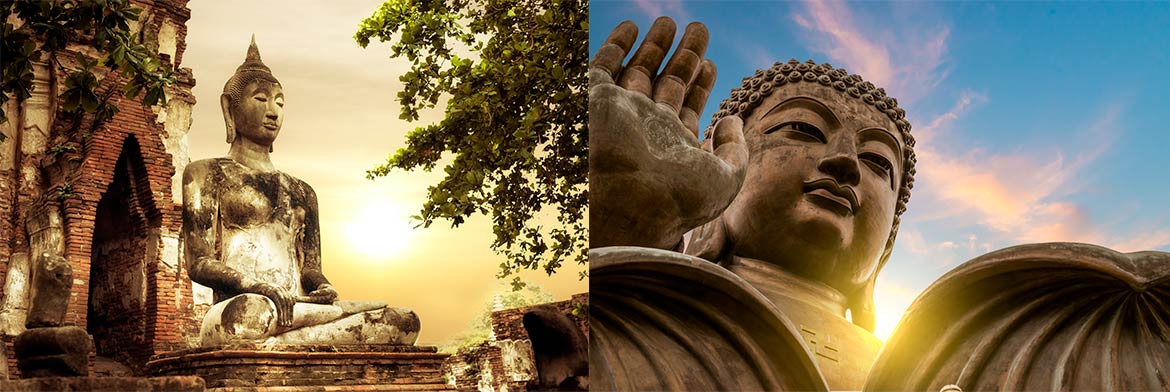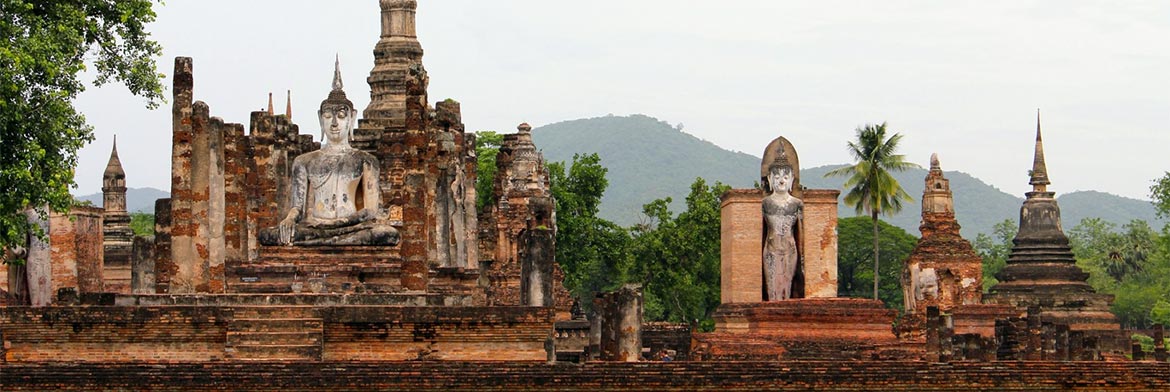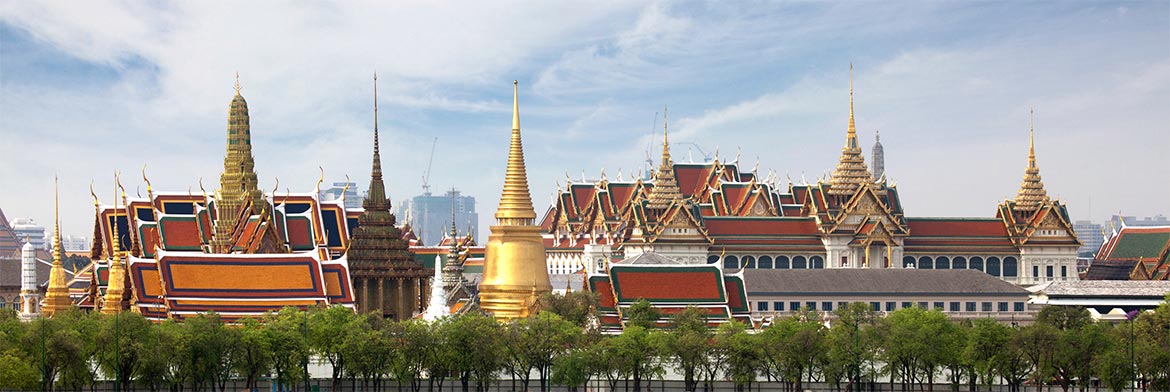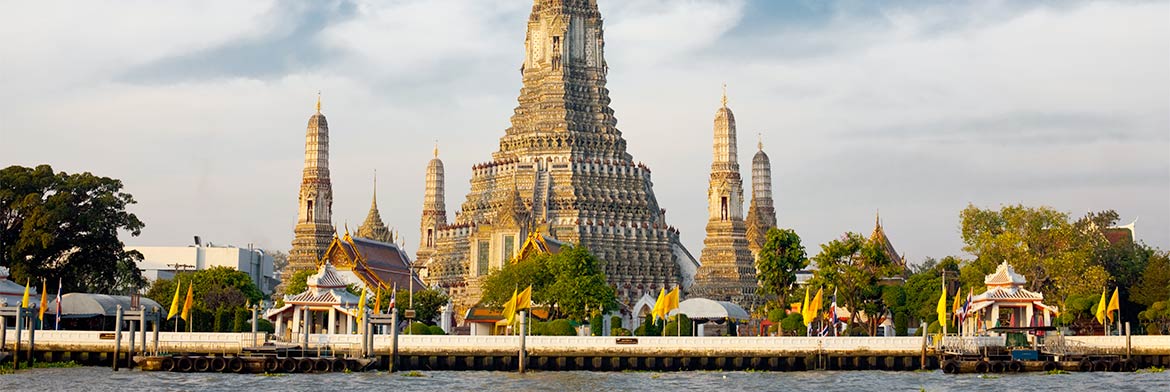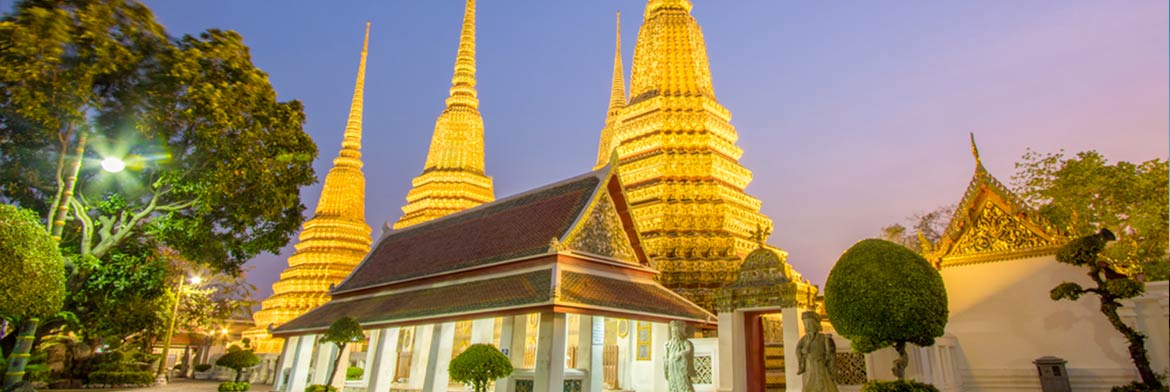 Thai Religion
Thai Religion
In Thailand the official religion is Theravāda Buddhism, which is followed by 94% of the population. Theravāda Buddhism, literally "the school of the elderly", is the most widespread form of Buddhism in South and South-East Asia, predominantly in Sri Lanka, Thailand, Cambodia, Burma and Laos. It is the oldest school of Buddhism between the existing ones. Theravāda Buddhism was originates from the first schools that arise from the teachings of Siddhartha Gautama, particularly from the school of Vibhajjavāda doctrine, a division of Sthaviravāda school. Theravāda Buddhism uses as its doctrinal core the Pāli Canon, a collection of the oldest Buddhist texts, but also include traditions and practices that have developed over its long history of interactions with cultures and communities. In Thailand, Theravāda Buddhism was adopted as official religion by King Ramathibodi, at time of Ayutthaya Kingdom. Actually the religion was already known and widespread many years before. Buddhism made its appearance in the territories of present-day Thailand in the Mon Dvāravatī period, or even before in the third century BC. The Mon Dvāravatī period was the earliest form of civilization in Thailand, previous to Khmer period, the first culture that certainly had adopted and spread the new religion in this region, which had its origins in India. Some ancient texts report testimony, in fact, that in the 3rd or 2nd century BC some monks were sent by the Indian Emperor Ashoka in a fertile territory called Suvarṇabhūmi, translatable in Land of Gold or Golden Land, to spread Theravāda Buddhism. The area mentioned in the text seems to match to the alluvial valley of river Mae Nam Chao Phraya or to a city among those of Suphanburi, Nakhon Pathom or more likely U-Thong, each of which, later on, became an important city-state of Dvāravatī period. Suphanburi, in fact, can be translated in City of Gold, U-Thong was also called Suphannaphum, translatable in Cradle of Gold, and Nakhon Pathom was certainly one of the first cities in the valley of Mae Nam Chao Phraya. In Nakhon Pathom there is historical evidence, still visible today, of the introduction of Buddhism in Thailand, the Phra Pathom Chedi. The original structure of temple is the oldest Buddhist edifice in the Kingdom, its construction dates back to the 3rd century BC.

 Buddhist Monks
Buddhist Monks
The Wats with its monks are the real load-bearing of the Thai public life, place of prayer but also a place of social cohesion and meeting. Theravāda Buddhism in Thailand is characterized by the constant presence of Buddhist monks inside the Wats. The monks serve as officiants on ceremonial occasions, as well as being responsible for preserving and transmit the teachings of the Buddha. The monks have also a very important role in public life, there is no civil or religious ceremony at which the monks do not participate in large numbers, but they are also available to the faithful for the everyday suggestions. In the temples the monks are still today the masters of a large part of the education of young Thai, religious and moral. In 20° century, before the creation of state-run schools in Thailand, the temples served as the primary form of education for most of Thai, the only schools available to the children of the farmers in the villages. Today the creation of a good apparatus of state-run schools, the number of children that study inside the temples has declined significantly, however, this form of teaching continues in the most rural areas. In the monasteries, Wats, in addition to the many monks of the profession, there are the lay monks. Most young Thai, especially men, spend a period of their life in a monastery. All monks, permanent and temporary, live exclusively of the offerings of the faithful. The monks and novices go to do the begging, at sunrise, in the streets of towns and villages and every Buddhist feels happy and proud to contribute to the sustenance of his monks. Young people, who start the novitiate, at the time of entering a convent are shaved and dressed with orange sackcloth, white for girl novices. The novitiate is a moral obligation for young Thai, no one is worthy of consideration if he has not made his novitiate. Young people, usually at 20 years, during this time live isolated from the outside world, and learn the essential theological elements of Buddhism. The duration of the novitiate is usually three months, usually done during the rainy season, after the young man becomes a Khon souk, or a mature man. Young Thai who do not complete the novitiate, or they do not do, are called Khon dip, i.e. half men. At the end of three months, if a young man stood out, may ask to remain in the convent three months more, this will bring you a lot of respect from his fellow citizens. At the end of this period, six-month total of novitiate, a novice can ask to be consecrated monk, then must take a vow of chastity and renounce all worldly goods.
Thai Temples
The Wats are the places of worship in Thailand. The word Wat is derived from Pāli "vatthu-ārāma", which means the place where the temple is built. The term Wat refers to a temple complex, not to a single structure, basically a Wat is a defined area within which are located several sacred edifices of Theravāda Buddhism. A Wat, including a area dedicated to worship, the Buddhavasa, the monks' residence area, the Sanghavasa, not always present, and often a school. The Phra Ubosot, usually named Bot in Thai, is the main temple of Buddhavasa area, also known as the ordination hall. The Ubosot is a edifice for worship, only for the monks, and is used for the monastic ordination rite. Inside it houses the largest immage of Buddha. In the temple complex there can only be a Phra Ubosot, and access is usually reserved only to monks. The Vihan is a temple similar to Phra Ubosot, but less lavish and less important. The building is used for worship, for monks and faithful, and for secondary assemblies. In Buddhavasa there may be several Vihan. The Chedi, the stupa Thai, has a reliquary function and contains the remains or sacred objects of Buddha. It has the shape of an elongated bell with a smooth surface, and a spire on top. The architecture bell-shaped has been imported by the Sri Lankan style. A Prang is a tall tower-like spire, usually richly carved, typical of the Hindu tradition of the Khmer period, were used to house statues of the deities in a small cell, which usually only had access to the sovereign. Subsequently, during the Kingdoms of Ayutthaya and Rattanakosin, they were built also in the most important Buddhist temples, used as reliquaries, the same function of the stupa. The Mondop is a square building opened on the sides, which usually has a pyramid-shaped roof, inside they are preserved texts or sacred objects, but can also be used to perform certain rituals. The Wats in Thailand are everywhere in the area, you find them in every remote corner of the country, often on the highest peaks but also in the middle of the rice fields of rural areas. Currently there are a total of more than 40,000 Buddhist temples in Thailand. Of these 34,000 are in current use, 32,000 belong to the order Maha Nikaya, 2,000 belong to the order Dhammayuttika Nikaya, both of Buddhist Theravāda school, 12 are of the order Nikaya Chinese and 13 are Anam Nikaya of Buddhist Mahayana school. The Wats are then also classified according to importance into different classes. Two hundred and seventy-two temples hold the status of Royal first class, included among these the Wat Phra Sri Rattana Satsadaram, better known as Wat Phra Kaew, the most sacred Buddhist temple in Thailand. Wat Phra Kaew, is the residence of the most sacred Buddhist sculpture in the Kingdom, the Phra Kaew Morakot, the Emerald Buddha, which is considered the palladium of Thai monarchy. The history of the Phra Kaew Morakot borders into legend, according to some historians it was sculpted around 234 BC in India, at Patna Bihar, and later was transferred to Sri Lanka. In a subsequent transfer, probably towards Myanmar, he fell to hand of the Khmer that led him to Angor Wat in Cambodia; in later years he was moved again, first in Sri Ayudhaya, the ancient capital of Siam, then to Lawo, Kampaeng Phet and finally in Chiang Rai. After its discovery in 1434, its history is more certain, was moved first to Lampang and Chiang Mai and then to Luang Prabang and Vientiane in Laos for 225 years, where he remained until 1778 when General Taksin captured Vientiane and, once he become King, moved it first in Thonburi, the first capital of Siam, and then to its current location in the March 22, 1784. The Emerald Buddha was made from a jade green absolutely perfect, and is situated between sculptures and gold ornaments, frescoes and paintings in the Phra Ubosot.
Note
Respect for religion in Thailand is equal to that to the Royal Family. The statues of Buddha are sacred for all Thai. You should never turn your back to the statues, even when you exit a temple is good practice to do it walking backwards. In your souvenir photos avoided to lean or climb on the statues. To enter the complex of temples, Wat, one must have decent clothing. The men and women who present at the entrance scantily clad, in a tank top and shorts, are invited to wear clothes or shawls, usually available for rent near entrance, or will not be allowed access to them. Within the Wat you must remove your shoes. Remember that when you sit kneeling before a statue of the Buddha, the feet must remain behind, and not toward the statue. The monks can not be touched by women, if you want to bid lay it into the offertory, the monks will take it later. The effigies of Buddha, statues or pendants, given from the monks for protection and luck, should never be placed below the belt.





